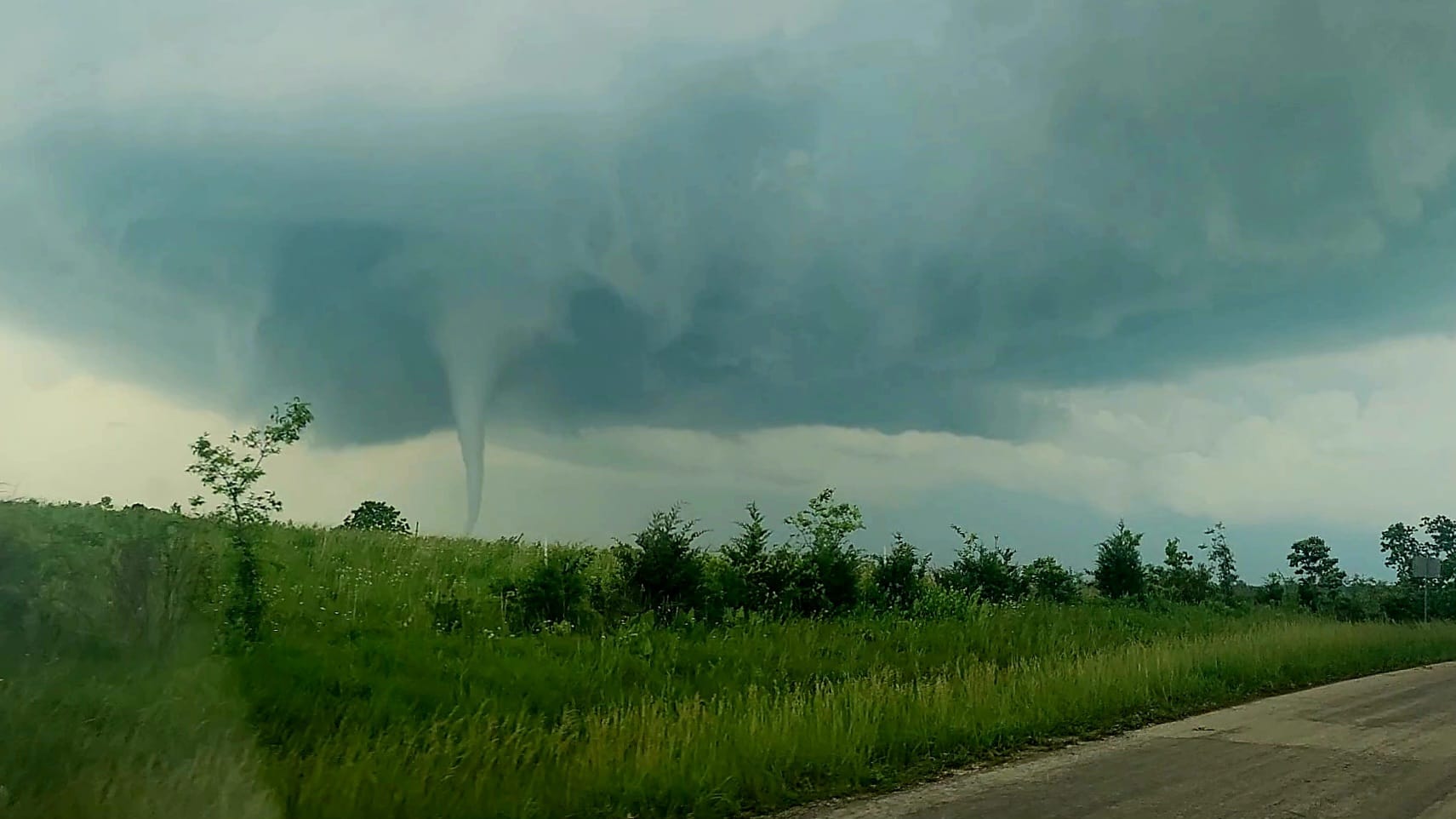We were lucky to catch up with Taylor Benton recently and have shared our conversation below.
Hi Taylor, thanks for joining us today. Let’s jump right into something we’re very focused on here – improving our ability to make decisions. Everyday, we’re faced with decisions that can impact the future of our careers, businesses, relationships and more and so one of the most impactful areas for personal development, in our view, is decision-making. Can you talk to us about how you developed or improved your decision-making skills?
Decision making. Something we do multiple times daily, yet never really think about in depth. Sometimes a decision is a knee-jerk reaction to something, or sometimes it’s a well-thought-out plan. There is no shortage of important decisions to make on a storm chase, and the wrong choice could be catastrophic. But this process does not start on chase day. It starts months prior, from saving money to chase with, to getting time off of work when peak season comes around. To successfully see a Tornado, a series of crucial decisions must be made correctly, but that process can start almost a year prior. Then comes chase day. You have done everything right so far to be in place, but now you must pick the right meteorological setup to travel for, the correct storm cell to follow, and the right road networks. Seeing a Tornado is all about being in the right place at the right time, but one wrong decision amid a chain of difficult choices can quickly ruin that opportunity, even if it’s something as simple as making a wrong turn and losing a few minutes of time.
Making the right decision, at the right time, is an art form. Sometimes, you want to move on a storm cell early. Sometimes it’s better to be patient and wait for another storm to come along. In the early days, I would abandon my area for another storm farther away, only to have a Tornado track through the original area after I was long gone. Likewise, sometimes I would sit stubbornly while a storm an hour away was dropping Tornadoes like crazy. So how do you filter it? I have found, and been mentored, that decision making usually comes down to logistics or emotion. We make emotional decisions all of the time, and they often contradict the logical choice, which is sometimes the harder choice even though it’s right. When storm chasing, it seems the logical decisions typically yield the most consistent results. The atmosphere follows the laws of Chemistry and Physics, after all.
But the best chasers out there have something extra. An ability to recognize, the few times, when the logical decision is actually less right. This is when intuition or a “gut feeling” comes in. Maybe this convinces the chaser to go to a secondary target area, or to gamble on a storm that has a higher boom/bust potential. Many times, following this intuition pays off extraordinarily. But one can never develop that intuition without exploring it and trying. And by trying, you are almost guaranteed failure along the way, which can be very disheartening.
Which is, in a nutshell, the whole point. With each failure comes a chance to learn and refine how you make your decisions. Through repetition, storm chasers learn when to move or sit, when to follow logic or emotion, and when to even head out to chase in the first place. Each opportunity is a chance to later review, learn, and apply to your next chase. The decision making, and the filter of which its done, is arguably the most important part of having a safe and successful chase. But like most things in life, it is a skill set that takes substantial time to develop. It can be quite a rollercoaster of emotions in a short span of time.

Great, so let’s take a few minutes and cover your story. What should folks know about you and what you do?
Storm chasing is a very unique hobby, and even more rare as a career. To the dedicated, it’s really a lifestyle. Only a small percentage of the population participates, and many of those folks rarely get to chase due to the constraints of life, work, and finances. It has taken years to be in position to chase even just a few times a year. A flexible job with caring managers, the right car, spendable money, forecasting knowledge, credible sources for information, a camera and all kinds of tech, the list goes on and on. I guess the point is commitment. There is a reason many chasers are so nutty about weather and often yell in excitement in their videos even if there is no Tornado. It’s because of the commitment it took to get to that moment in time. The journey. They are truly all in, regardless of cost, and that level of passion is hard to find in an age of digital dopamine and instant gratification. Storm chasers may be nerdy or even annoying sometimes, but most of them are free spirited people just looking for a way to connect with nature.
Personally speaking, the goal is always to see more Tornadoes than the year prior, and to grow the social media channels of course. But this year will also focus on recovery and first aid. Every chaser can provide help in a disaster scenario, but the quality of help can be the difference maker for someone else. If we are going to be out there gawking at nature’s masterpiece, we should be useful when the time comes. It is only fair. The official plan is, still, to finish a meteorology degree and work as an operational forecaster, but that is another topic.

If you had to pick three qualities that are most important to develop, which three would you say matter most?
1) Forecasting/Understanding of weather systems
2) Actual chasing/positioning strategies/decision making
3) Photography/videography
Safe and successful storm chasing requires various skill sets. These skill sets take time and repetition to hone and develop and can easily regress the same way your muscles would if you stopped going to the gym consistently. The first major point was learning how to read weather maps, interpret computer models, and identify signs that indicate severe weather was on the horizon. This was accomplished through trial and error, as well as YouTube videos and direct conversations one on one with actual meteorologists. You cannot plan a chase trip if you do not know when and where the storms will be! Accurate forecasting, and understanding the evolution of large-scale storm systems, was the first lightbulb to click on. One noticeable gain was learning the terminology from meteorologists as used in their official forecasts. Learning the lingo and the context it used in, was when things really started to make sense.
Now the second part. You have correctly identified a spring storm system with Tornado potential. But the region of possible activity stretches from north Texas to cental Iowa, well over 1000 square miles. There will be storms along that entire swath of land, but only a few of them will produce Tornadoes and only for a brief window of time. Now what? Knowing which cell to pick and when, is arguably the hardest part of storm chasing. But as described earlier, it is also an art form. The truth is, there is no right answer that works every single time. Meteorology is not an exact science. Sometimes the best decision making is logical, and sometimes it is emotional or intuitive. It just really depends on the situation and how the atmosphere is evolving. But that awareness to recognize the correct play, is everything. The only way to learn that awareness is to try, try again, and keep trying.
Lastly, the photography aspect of things. Depending on your goals, this part might be very important or not that important at all. But if you want a memory, or proof you were there, a picture is mandatory. This part can also be frustrating though, as you may have a Tornado in front of you but fail to capture it effectively. Nothing is worse than getting all of your decisions correct to be in position and then fail to get a good shot. For the professionals, this is their income, and a bad shot can mean no payment or reward for their efforts. So, the photography side matters, depending on your goals as a chaser. Even if you need to provide ground truth to the national weather service, a good picture surely helps!
In the end, all three skills go hand in hand. You will find that the most popular and successful chasers, have mastered all three points and blend them together in the moment. Most amateur chasers, me included, may have a good grip on one or two of those points, but not all three. If you want to be top tier and on the level of a professional, you will need to master all three. Turning pro at anything, is a personal choice and a commitment. Storm chasing is no different. You must be consistent at constantly getting better and not give up when it’s convenient too.

Is there a particular challenge you are currently facing?
A little introspection here. It kills me to say this, but right now my “why” is in question. Every storm chaser starts somewhere. It may be a childhood experience with severe weather, the movie Twister, or something they saw on a TV show. But regardless, every single chaser starts chasing because of some kind of curiosity or need for adventure. It evolves from there. Some turn it into a profession. Others get deep into research or academia. There are now even entire families who take “chasecations” together, and there are even tour vans running full flown businesses taking people from overseas around the country to see the storms! Everyone has their “why” for being out there. I am the same. It started as a curiosity and a childhood fascination. But over time, it became more. More and more people would tell me “you should get on Instagram!” or “you don’t have a Tik Tok for your storm footage?” So then social media got involved. With social media came opportunities to make money, which changed the dynamic a bit. It brought new friends and opportunities centered around weather, but it also brought competition and lots of anxiety. Even these interviews, while I do like doing them, bring some anxiety from opening up to the internet. After building a decent following, folks would message me and say, “you need to go to school for this!” I could not help but agree, so that was what came next. A year and half later and I had an associate’s degree in science. Since then, the math has gotten extremely difficult. While I knew it would, it genuinely has me questioning if I can do it, or if I even want too. The social media side of things sometimes has me feeling like I’m chasing for the wrong reasons. And lastly, it is hard to justify being excited about something that robs people of their property or loved ones, even if it is fairly rare. The moral ambiguity of storm chasing weighs on every chaser, but it can be quite suffocating in specific moments and seems to be getting heavier and heavier as time goes by. All of that being said, I do not plan to ever stop chasing storms. But there may come a day when I don’t do it as often, and don’t broadcast it anymore. I do not want to lose that passion and enthusiasm I have, all for social media clout and a few dollars, possibly at someone else’s expense. I am looking forward to this coming season, because I want to get back to the root of my “why.” Spring of 2025 is right around the corner!
Contact Info:
- Instagram: tornado_genesis
- Facebook: https://www.facebook.com/@taylor.benton.984
- Youtube: https://www.youtube.com/@tornado_genesis






Image Credits
Taylor Benton. All images are my own!
so if you or someone you know deserves recognition please let us know here.




